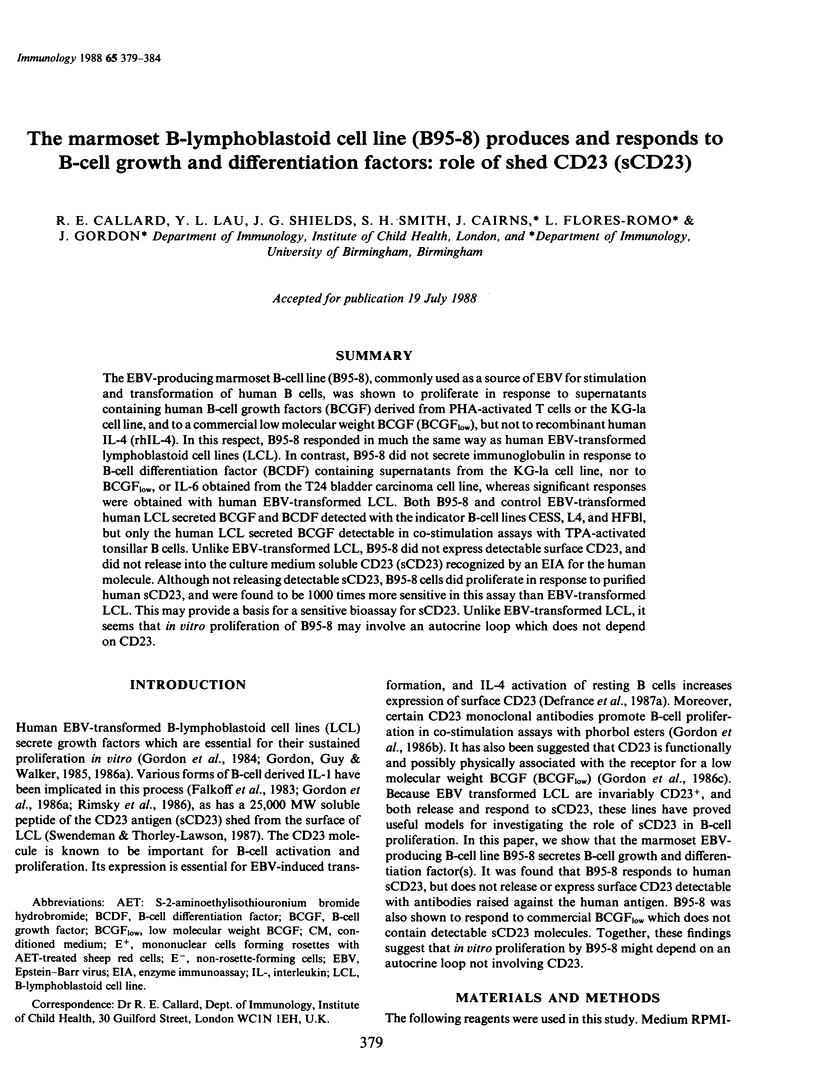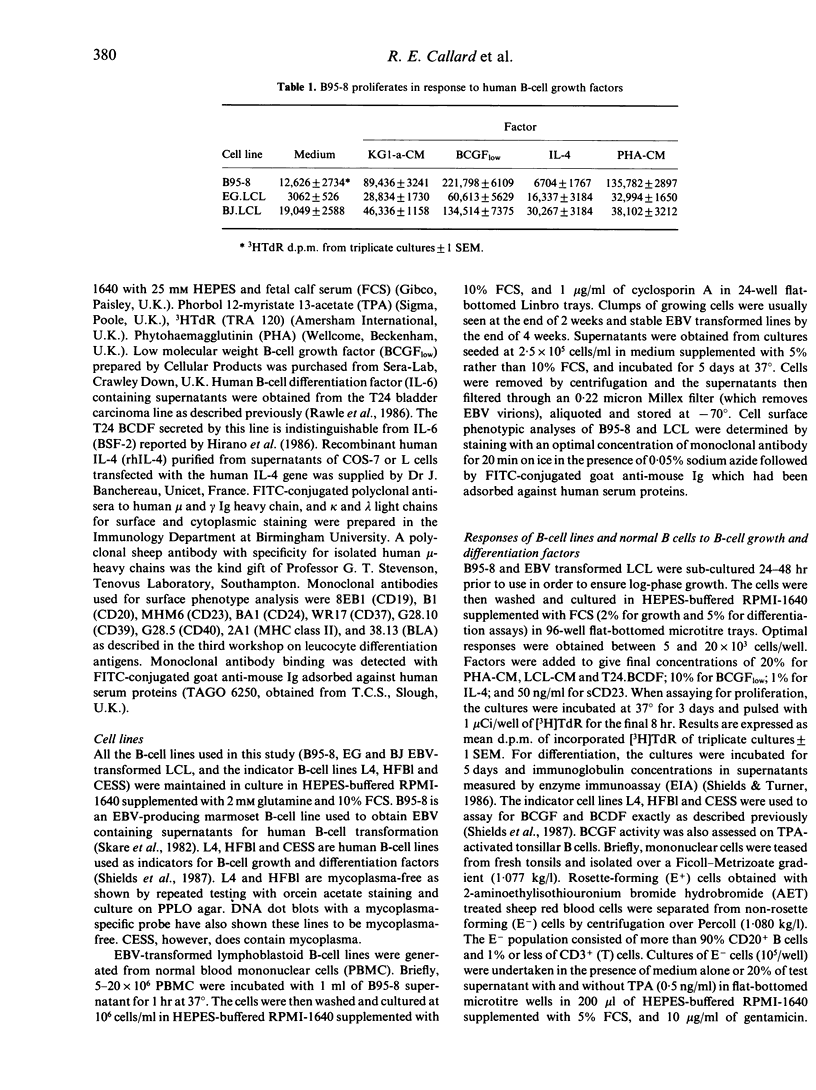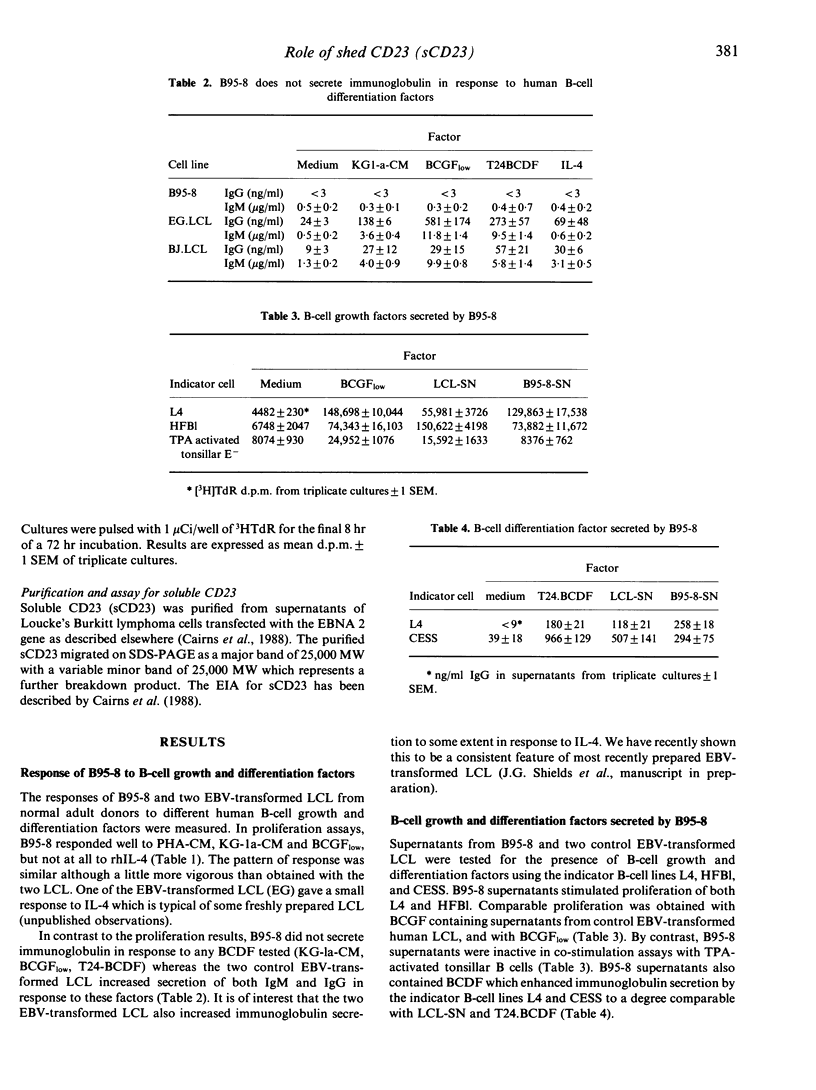Abstract
The EBV-producing marmoset B-cell line (B95-8), commonly used as a source of EBV for stimulation and transformation of human B cells, was shown to proliferate in response to supernatants containing human B-cell growth factors (BCGF) derived from PHA-activated T cells or the KG-la cell line, and to a commercial low molecular weight BCGF (BCGFlow), but not to recombinant human IL-4 (rhIL-4). In this respect, B95-8 responded in much the same way as human EBV-transformed lymphoblastoid cell lines (LCL). In contrast, B95-8 did not secrete immunoglobulin in response to B-cell differentiation factor (BCDF) containing supernatants from the KG-la cell line, nor to BCGFlow, or IL-6 obtained from the T24 bladder carcinoma cell line, whereas significant responses were obtained with human EBV-transformed LCL. Both B95-8 and control EBV-transformed human LCL secreted BCGF and BCDF detected with the indicator B-cell lines CESS, L4, and HFB1, but only the human LCL secreted BCGF detectable in co-stimulation assays with TPA-activated tonsillar B cells. Unlike EBV-transformed LCL, B95-8 did not express detectable surface CD23, and did not release into the culture medium soluble CD23 (sCD23) recognized by an EIA for the human molecule. Although not releasing detectable sCD23, B95-8 cells did proliferate in response to purified human sCD23, and were found to be 1000 times more sensitive in this assay than EBV-transformed LCL. This may provide a basis for a sensitive bioassay for sCD23. Unlike EBV-transformed LCL, it seems that in vitro proliferation of B95-8 may involve an autocrine loop which does not depend on CD23.
Full text
PDF





Selected References
These references are in PubMed. This may not be the complete list of references from this article.
- Ambrus J. L., Jr, Jurgensen C. H., Brown E. J., Fauci A. S. Purification to homogeneity of a high molecular weight human B cell growth factor; demonstration of specific binding to activated B cells; and development of a monoclonal antibody to the factor. J Exp Med. 1985 Oct 1;162(4):1319–1335. doi: 10.1084/jem.162.4.1319. [DOI] [PMC free article] [PubMed] [Google Scholar]
- Bickel M., Amstad P., Tsuda H., Sulis C., Asofsky R., Mergenhagen S. E., Pluznik D. H. Induction of granulocyte-macrophage colony-stimulating factor by lipopolysaccharide and anti-immunoglobulin M-stimulated murine B cell lines. J Immunol. 1987 Nov 1;139(9):2984–2988. [PubMed] [Google Scholar]
- Blazar B. A., Sutton L. M., Strome M. Self-stimulating growth factor production by B-cell lines derived from Burkitt's lymphomas and other lines transformed in vitro by Epstein-Barr virus. Cancer Res. 1983 Oct;43(10):4562–4568. [PubMed] [Google Scholar]
- Buck J., Hämmerling U., Hoffmann M. K., Levi E., Welte K. Purification and biochemical characterization of a human autocrine growth factor produced by Epstein-Barr virus-transformed B cells. J Immunol. 1987 May 1;138(9):2923–2928. [PubMed] [Google Scholar]
- Cairns J., Flores-Romo L., Millsum M. J., Guy G. R., Gillis S., Ledbetter J. A., Gordon J. Soluble CD23 is released by B lymphocytes cycling in response to interleukin 4 and anti-Bp50 (CDw40). Eur J Immunol. 1988 Mar;18(3):349–353. doi: 10.1002/eji.1830180305. [DOI] [PubMed] [Google Scholar]
- Clark E. A., Ledbetter J. A. Activation of human B cells mediated through two distinct cell surface differentiation antigens, Bp35 and Bp50. Proc Natl Acad Sci U S A. 1986 Jun;83(12):4494–4498. doi: 10.1073/pnas.83.12.4494. [DOI] [PMC free article] [PubMed] [Google Scholar]
- Defrance T., Aubry J. P., Rousset F., Vanbervliet B., Bonnefoy J. Y., Arai N., Takebe Y., Yokota T., Lee F., Arai K. Human recombinant interleukin 4 induces Fc epsilon receptors (CD23) on normal human B lymphocytes. J Exp Med. 1987 Jun 1;165(6):1459–1467. doi: 10.1084/jem.165.6.1459. [DOI] [PMC free article] [PubMed] [Google Scholar]
- Defrance T., Vanbervliet B., Aubry J. P., Takebe Y., Arai N., Miyajima A., Yokota T., Lee F., Arai K., de Vries J. E. B cell growth-promoting activity of recombinant human interleukin 4. J Immunol. 1987 Aug 15;139(4):1135–1141. [PubMed] [Google Scholar]
- Falkoff R. J., Muraguchi A., Hong J. X., Butler J. L., Dinarello C. A., Fauci A. S. The effects of interleukin 1 on human B cell activation and proliferation. J Immunol. 1983 Aug;131(2):801–805. [PubMed] [Google Scholar]
- Gordon J., Guy G., Walker L. Autocrine models of B-lymphocyte growth. I. Role of cell contact and soluble factors in T-independent B-cell responses. Immunology. 1985 Oct;56(2):329–335. [PMC free article] [PubMed] [Google Scholar]
- Gordon J., Guy G., Walker L. Autocrine models of B-lymphocyte growth. II. Interleukin-1 supports the proliferation of transformed lymphoblasts but not the stimulation of resting B cells triggered through their receptors for antigen. Immunology. 1986 Mar;57(3):419–423. [PMC free article] [PubMed] [Google Scholar]
- Gordon J., Ley S. C., Melamed M. D., Aman P., Hughes-Jones N. C. Soluble factor requirements for the autostimulatory growth of B lymphoblasts immortalized by Epstein-Barr virus. J Exp Med. 1984 May 1;159(5):1554–1559. doi: 10.1084/jem.159.5.1554. [DOI] [PMC free article] [PubMed] [Google Scholar]
- Gordon J., Millsum M. J., Guy G. R., Ledbetter J. A. Resting B lymphocytes can be triggered directly through the CDw40 (Bp50) antigen. A comparison with IL-4-mediated signaling. J Immunol. 1988 Mar 1;140(5):1425–1430. [PubMed] [Google Scholar]
- Gordon J., Rowe M., Walker L., Guy G. Ligation of the CD23,p45 (BLAST-2,EBVCS) antigen triggers the cell-cycle progression of activated B lymphocytes. Eur J Immunol. 1986 Sep;16(9):1075–1080. doi: 10.1002/eji.1830160908. [DOI] [PubMed] [Google Scholar]
- Gordon J., Webb A. J., Walker L., Guy G. R., Rowe M. Evidence for an association between CD23 and the receptor for a low molecular weight B cell growth factor. Eur J Immunol. 1986 Dec;16(12):1627–1630. doi: 10.1002/eji.1830161225. [DOI] [PubMed] [Google Scholar]
- Ledbetter J. A., Shu G., Gallagher M., Clark E. A. Augmentation of normal and malignant B cell proliferation by monoclonal antibody to the B cell-specific antigen BP50 (CDW40). J Immunol. 1987 Feb 1;138(3):788–794. [PubMed] [Google Scholar]
- Matsushima K., Akahoshi T., Yamada M., Furutani Y., Oppenheim J. J. Properties of a specific interleukin 1 (IL 1) receptor on human Epstein Barr virus-transformed B lymphocytes: identity of the receptor for IL 1-alpha and IL 1-beta. J Immunol. 1986 Jun 15;136(12):4496–4502. [PubMed] [Google Scholar]
- Matsushima K., Tosato G., Benjamin D., Oppenheim J. J. B-cell-derived interleukin-1 (IL-1)-like factor. II. Sources, effects, and biochemical properties. Cell Immunol. 1985 Sep;94(2):418–426. doi: 10.1016/0008-8749(85)90265-5. [DOI] [PubMed] [Google Scholar]
- Mehta S. R., Conrad D., Sandler R., Morgan J., Montagna R., Maizel A. L. Purification of human B cell growth factor. J Immunol. 1985 Nov;135(5):3298–3302. [PubMed] [Google Scholar]
- Muraguchi A., Nishimoto H., Kawamura N., Hori A., Kishimoto T. B cell-derived BCGF functions as autocrine growth factor(s) in normal and transformed B lymphocytes. J Immunol. 1986 Jul 1;137(1):179–186. [PubMed] [Google Scholar]
- Rawle F. C., Shields J., Smith S. H., Iliescu V., Merkenschlager M., Beverley P. C., Callard R. E. B cell growth and differentiation induced by supernatants of transformed epithelial cell lines. Eur J Immunol. 1986 Aug;16(8):1017–1019. doi: 10.1002/eji.1830160825. [DOI] [PubMed] [Google Scholar]
- Rimsky L., Wakasugi H., Ferrara P., Robin P., Capdevielle J., Tursz T., Fradelizi D., Bertoglio J. Purification to homogeneity and NH2-terminal amino acid sequence of a novel interleukin 1 species derived from a human B cell line. J Immunol. 1986 May 1;136(9):3304–3310. [PubMed] [Google Scholar]
- Rubin B. Y., Anderson S. L., Sullivan S. A., Williamson B. D., Carswell E. A., Old L. J. Purification and characterization of a human tumor necrosis factor from the LuKII cell line. Proc Natl Acad Sci U S A. 1985 Oct;82(19):6637–6641. doi: 10.1073/pnas.82.19.6637. [DOI] [PMC free article] [PubMed] [Google Scholar]
- Scala G., Kuang Y. D., Hall R. E., Muchmore A. V., Oppenheim J. J. Accessory cell function of human B cells. I. Production of both interleukin 1-like activity and an interleukin 1 inhibitory factor by an EBV-transformed human B cell line. J Exp Med. 1984 Jun 1;159(6):1637–1652. doi: 10.1084/jem.159.6.1637. [DOI] [PMC free article] [PubMed] [Google Scholar]
- Shields J. G., Smith S. H., Levinsky R. J., DeFrance T., De Vries J. E., Banchereau J., Callard R. E. The response of selected human B cell lines to B cell growth and differentiation factors. Eur J Immunol. 1987 Apr;17(4):535–540. doi: 10.1002/eji.1830170416. [DOI] [PubMed] [Google Scholar]
- Skare J., Edson C., Farley J., Strominger J. L. The B95-8 isolate of Epstein-Barr virus arose from an isolate with a standard genome. J Virol. 1982 Dec;44(3):1088–1091. doi: 10.1128/jvi.44.3.1088-1091.1982. [DOI] [PMC free article] [PubMed] [Google Scholar]
- Swendeman S., Thorley-Lawson D. A. The activation antigen BLAST-2, when shed, is an autocrine BCGF for normal and transformed B cells. EMBO J. 1987 Jun;6(6):1637–1642. doi: 10.1002/j.1460-2075.1987.tb02412.x. [DOI] [PMC free article] [PubMed] [Google Scholar]
- Taira S., Matsui M., Hayakawa K., Yokoyama T., Nariuchi H. Interleukin secretion by B cell lines and splenic B cells stimulated with calcium ionophore and phorbol ester. J Immunol. 1987 Nov 1;139(9):2957–2964. [PubMed] [Google Scholar]
- Uittenbogaart C. H., Fahey J. L. Leukemia-derived growth factor (non-interleukin 2) produced by a human malignant T lymphoid cell line. Proc Natl Acad Sci U S A. 1982 Nov;79(22):7004–7008. doi: 10.1073/pnas.79.22.7004. [DOI] [PMC free article] [PubMed] [Google Scholar]
- de Larco J. E., Todaro G. J. Growth factors from murine sarcoma virus-transformed cells. Proc Natl Acad Sci U S A. 1978 Aug;75(8):4001–4005. doi: 10.1073/pnas.75.8.4001. [DOI] [PMC free article] [PubMed] [Google Scholar]


